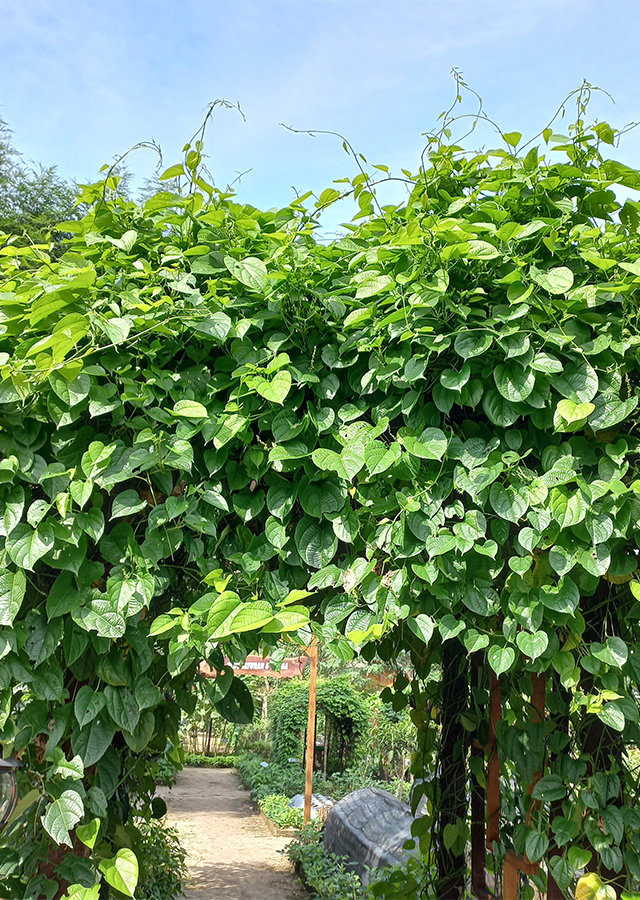Sacha Inchi
Plukenetia volubilis L.
Euphorbiaceae
Location in our garden
Principal



Synonym
Fragariopsis paxii Pittier
Plukenetia macrostyla Ule
Plukenetia peruviana Müll.Arg.
Habitus
Climbers. Wild, woody/semiwoody, climbing perennial oleaginous plant that grows about 2 metres tall.
Part Used
Leaves
Seeds
Growing Requirements
Full Sunshine
Habitat
Riverbanks
Forest
Terrestrial
Overview
Sacha inchi is native to tropical South America (Suriname, Venezuela, Bolivia, Colombia, Ecuador, Peru, and northwestern Brazil), as well as some of the Windward Islands in the Caribbean. It is cultivated commercially in South East Asia, most notably in Thailand, and is recognised in other parts of the world as a sustainable crop with viable commercial applications. The edible seeds and leaves are gathered from the wild for local use. In recent years, there has been growing interest in developing the sacha inchi plant as a novel source of oil rich in unsaturated fatty acids.The whole sacha inchi plant has been utilized to generate nutritional, cosmetic, and pharmaceutical products with the goal to maximize its economic value. The nut is often consumed after they have been roasted. Furthermore, the oil extracted from sacha inchi is highly sought after as it is packed with antioxidants, vitamins, and minerals.
Vernacular Names
Kyaal pell (Burmese), Sacha inchi (Dutch), Öljymaniköynnös (Finnish), Inca inchi (French), Inka-Nuss (German), Arachide dell’Inca (Italian), Sacha inchi, Sacha maní (Spanish).
Agroecology
The plant occurs in disturbed areas or forest edges of lowland moist or wet forest and will grow in warm climates up to altitudes of 1.700 meters as long as there is continued availability of water and good drainage. It grows better in acidic soils and alluvial flats near rivers.
Morphology
- Leaves - Alternate, heart shaped, serrated leaves, 10 to 12 cm long and 8 to 10 cm wide, that have petioles 2-6 cm long.
- Flower - The male flowers are small, white, and arranged in clusters. Two female flowers are located at the base of the inflorescence.
- Fruit - Star-shaped fruit pod, capsules of 3 to 5 cm in diameter with 4 to 7 points. Fruit capsules usually consist of 4 to 5 lobes, but some may have up to 7. Green when young turning to blackish brown as they matures.
- Flesh - Soft black wet pulp.
- Seed - Oval, dark-brown, 1,5 to 2 cm in diameter with a mass of 45 to 100 grams.
Cultivation
Generative propagation is by seeds.
Chemical Constituents
Essential amino acids, tryptophan, omega fatty acids (α-linolenic acid, linoleic acid), gamma-tocopherol, and phenolic compounds, monoterpenes, sesquiterpenes, triterpenes, terpenoids (α-pinene, sabinene, limonene, aristolene, cycloartenol, 24-methylene cycloartenol, lanosterol, β-sitosterol, stigmasterol, campesterol and phytol).
Traditional Medicinal Uses
- Sacha inchi balances the cholesterol level in the body and reduces the LDL or bad cholesterol level in the body.
- It is used to treat cardiovascular diseases and reduces the blood pressure.
- It is good for weight loss and helps to regulate the appetite and reduces food cravings.
- It regulates the glucose level in the Body and also lowers the Triglyceride levels in diabetic patients.
- It regulates the oil production and locks hydration in the kkin.
- Sacha inchi improves vision and maintains eye health.
- It eases joint pain and rheumatoid arthritis.
- It soothes irritation and calms inflammation of the scalp, especially on scalps that suffer from uncomfortable symptoms associated with dandruff, psoriasis, or eczema.
Part Used
Reference Sources
- Fern, Ken. (2014). Useful Tropical Plants: Plukenetia volubilis L. http://tropical.theferns.info/viewtropical.php?id=Plukenetia+volubilis. 25-10-2021.
- Health Benefits Times. (No date). Health benefits of Sacha Inchi. https://www.healthbenefitstimes.com/sacha-inchi/. 24-10-2021.
- Tiny Quality Home. (2021). 18 Uses And Health Benefits Of Sacha Inchi. https://tinyqualityhome.com/health-benefits/uses-and-benefits-of-sacha-inchi/.24-10-2021.
- Valencia, A., Romero-Orejon, F., et all. (2021). Sacha Inchi Seed (Plukenetia volubilis L.) Oil: Terpenoids. DOI: 10.5772/intechopen.96690. https://www.intechopen.com/chapters/75634. 25-10-2021.
- Wang, Sunan, Zhu, F., and Kakuda, Y. (2018). Sacha inchi (Plukenetia volubilis L.): Nutritional composition, biological activity, and uses. https://pubmed.ncbi.nlm.nih.gov/29884388/. 24-10-2021.

